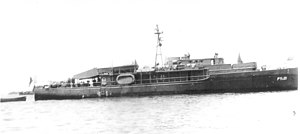USS Alabaster
 USS Alabaster (PYc-21) at anchor in San Pedro Bay, Philippine Islands while at Navy Yard for modification. c. July 1945
| |
| History | |
|---|---|
| Name | Alamo |
| Owner | William F. Ladd |
| Builder | Mathis Yacht Building Company, Camden, New Jersey |
| Launched | 1932 |
| Fate | Sold in 1934 to Lucius B. Manning, President of the Cord Automobile Corp |
| Name | Ronaele |
| Owner | Lucius B. Manning |
| Acquired | 1934 |
| Fate | Sold back to William F. Ladd in 1936 |
| Name | Rellimpa, Ranley and Ronaele |
| Owner | William F. Ladd |
| Acquired | 1936 |
| Fate | Sold to the Navy 3 January 1942 |
| Name | Alabaster |
| Namesake | Alabaster |
| Builder | Philadelphia Navy Yard |
| Acquired | 3 January 1942 |
| Commissioned | 31 January 1942 |
| Decommissioned | 17 December 1945 |
| Stricken | 21 January 1946 |
| Fate |
|
| General characteristics | |
| Type | Patrol boat |
| Displacement | 230 long tons (234 t) |
| Length | 143 ft (44 m) |
| Beam | 23 ft 5 in (7.14 m) |
| Draft | 12 ft 5 in (3.78 m) |
| Speed | 14.5 knots (26.9 km/h; 16.7 mph) |
| Complement | 48 |
| Armament |
|
The USS Alabaster (PYc-21) was a coastal patrol yacht of the United States Navy during World War II.
The ship was built in 1932 by the
The yacht was acquired by the U.S. Navy on 3 January 1942, renamed Alabaster on 13 January 1942 and simultaneously classified a coastal patrol yacht and designated PYc-21. Converted by the
Service history
World War II, 1942–1945
Assigned to the Inshore Patrol and based at the section base at
On 5 January 1944, she completed her training and received orders to report to the Commander,
The end of the war in mid-August 1945 found her still at Leyte, and she was then declared surplus to the needs of the Navy. The yacht cleared San Pedro Bay to return to the United States. Steaming via
In private ownership, 1947–1982
Alabaster was initially sold on 9 April 1947 to Lyman A. Whitney, of San Diego, California,[3] however this purchase was never completed, and she was finally purchased by Col. C. S. Smith, USAR, Ret., who restored her as a private cruising yacht and renamed her Alamo.[4]
In 1959–1960 she was the setting (called Fortuna II) for the CBS television series Mr. Lucky, starring John Vivyan, Ross Martin and Pippa Scott.[4]
Alamo was sold in 1960 to Enrique Braun of Acapulco, renamed Fiesta II, and served as a harbor cruise vessel until 1982. In that year it was sold and towed to Puerto Vallarta to be converted to a floating restaurant. It caught fire and sank during conversion and its wreckage is now a popular scuba diving venue.[4]
References
- Notes
- ^ "Alamo – William F. Ladd's Motor Yacht". Motor Boating. Vol. LI, no. 3. March 1933. pp. 24–25. Retrieved 1 September 2018.
- ^ Colton, Tim (6 June 2018). "Mathis Yacht Building, Camden and Gloucester City NJ". ShipbuildingHistory. Retrieved 1 September 2018.
- ^ a b c d e "USS Alabaster". Dictionary of American Naval Fighting Ships. 2004. Retrieved 25 October 2011.
- Bibliography
- This article incorporates text from the public domain Dictionary of American Naval Fighting Ships. The entries can be found here and here.
- Photo gallery of USS Alabaster at NavSource Naval History
